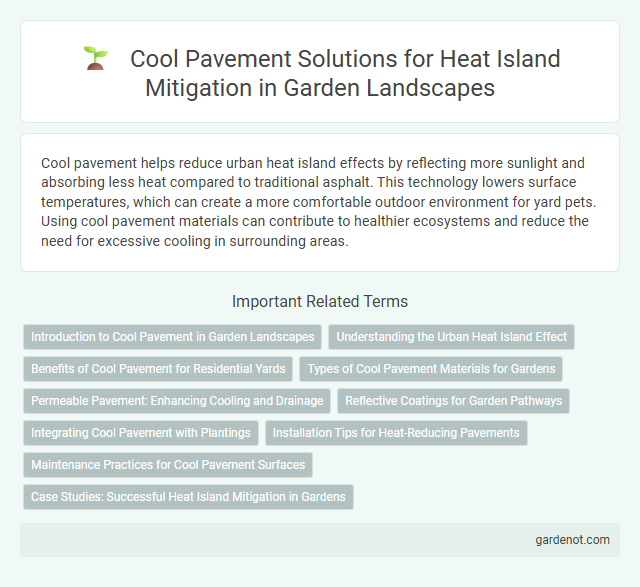Cool pavement helps reduce urban heat island effects by reflecting more sunlight and absorbing less heat compared to traditional asphalt. This technology lowers surface temperatures, which can create a more comfortable outdoor environment for yard pets. Using cool pavement materials can contribute to healthier ecosystems and reduce the need for excessive cooling in surrounding areas.
Introduction to Cool Pavement in Garden Landscapes
Cool pavement technologies in garden landscapes reduce surface temperatures by reflecting more sunlight and enhancing water evaporation compared to traditional asphalt. Materials such as permeable concrete, reflective coatings, and light-colored aggregates improve urban heat island mitigation by lowering heat absorption in yards. Integrating cool pavements with vegetation optimizes thermal comfort and enhances microclimate regulation within residential gardens.
Understanding the Urban Heat Island Effect
Cool pavement plays a crucial role in mitigating the urban heat island (UHI) effect by reflecting more solar energy and absorbing less heat compared to traditional asphalt surfaces. The UHI effect results in significantly higher temperatures in urban areas due to dense infrastructure, reduced vegetation, and heat-absorbing materials, which exacerbate energy consumption and elevate health risks. Implementing cool pavement technologies helps lower surface temperatures, reduce ambient air temperatures, and enhance urban thermal comfort, contributing to sustainable city planning.
Benefits of Cool Pavement for Residential Yards
Cool pavement in residential yards significantly reduces surface temperatures by reflecting more sunlight and absorbing less heat compared to traditional materials. This temperature reduction lowers the surrounding air temperature, mitigating the urban heat island effect and creating a more comfortable outdoor environment. Enhanced energy efficiency results from reduced cooling needs in nearby homes, while increased durability and resistance to cracking extend the lifespan of paved surfaces.
Types of Cool Pavement Materials for Gardens
Cool pavement materials for gardens include permeable concrete, reflective coatings, and light-colored aggregates that reduce heat absorption and promote cooling. Permeable concrete enhances water infiltration while lowering surface temperatures, making it ideal for garden pathways and patios. Reflective coatings contain materials like titanium dioxide to deflect solar radiation, further contributing to heat island mitigation in outdoor green spaces.
Permeable Pavement: Enhancing Cooling and Drainage
Permeable pavement significantly reduces urban heat island effects by allowing water to infiltrate through its porous surface, enhancing cooling through evaporative processes. This type of pavement improves stormwater management by promoting natural drainage and reducing runoff, which helps maintain lower surface temperatures. Incorporating permeable materials in heat island mitigation yards leads to more sustainable, cooler urban environments while supporting groundwater recharge.
Reflective Coatings for Garden Pathways
Reflective coatings for garden pathways in heat island mitigation yards significantly reduce surface temperatures by increasing solar reflectance and lowering heat absorption. These coatings, often composed of light-colored or specially formulated pigments, enhance the cooling effect and improve pedestrian comfort during hot weather. Implementing reflective surfaces in garden pathways not only minimizes urban heat buildup but also contributes to energy savings in surrounding areas.
Integrating Cool Pavement with Plantings
Integrating cool pavement with plantings enhances urban heat island mitigation by combining reflective surfaces with vegetation's natural cooling effects. Strategically placed trees and shrubs adjacent to cool pavement reduce surface temperatures through shading and evapotranspiration, maximizing thermal comfort. This synergy lowers ambient temperatures, improves air quality, and supports sustainable urban design.
Installation Tips for Heat-Reducing Pavements
Selecting light-colored, high-reflectance materials enhances the effectiveness of cool pavements by minimizing heat absorption in urban heat island areas. Proper surface preparation, including thorough cleaning and leveling, ensures optimal adherence and longevity of heat-reducing pavements. Implementing permeable pavement designs improves water infiltration and cooling performance, further mitigating heat island effects.
Maintenance Practices for Cool Pavement Surfaces
Effective maintenance practices for cool pavement surfaces include regular cleaning to remove dirt, debris, and pollutants that can reduce reflectivity and thermal performance. Periodic inspections help identify and repair cracks or surface damage promptly, preventing heat absorption and degradation. Applying reflective sealants or coatings during maintenance extends the pavement's cooling efficiency and durability in heat island mitigation efforts.
Case Studies: Successful Heat Island Mitigation in Gardens
Cool pavement techniques in garden settings have demonstrated significant reductions in surface temperatures, with studies showing decreases of up to 10degF compared to conventional materials. Research from urban heat island mitigation projects highlights permeable concrete and reflective coatings as effective solutions that improve thermal comfort and reduce ambient heat. In several case studies, gardens retrofitted with cool pavements contributed to lower local air temperatures and enhanced vegetation health, supporting sustainable microclimate management.
Cool pavement Infographic

 gardenot.com
gardenot.com